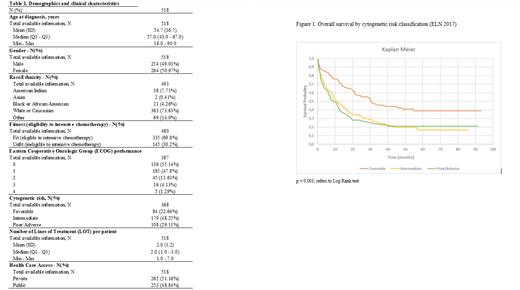Introduction. Acute myeloid leukemia (AML) is the most frequent leukemia among adults and representing 90% of all cases of acute leukemia in adults. Differences in incidence and burden of AML among regions of the world have been reported. When compared with registries from the US, UK and Sweden, Latin-America (LA) AML has a younger age at diagnosis (median age of 40-47 versus 64 -67 years old). Furthermore, single center studies have suggested poor treatment outcomes in LA. For example, Silveira et al reported a median age at diagnosis of 46 y, frequency of favorable cytogenetics of 26% and median overall survival (mOS) of 12 months in the Brazilian cohort of patients with newly diagnosed AML (nAML) whereas the respective values at Oxford University were 51.5y, 11% and 48 months in British patients. However, wider studies across the region are scarce and there is a need to further explore AML patient characteristics and treatment outcomes in LA.
Methods. This is a non-interventional, retrospective multicenter study that aims to describe the epidemiology, clinical and demographic characteristics, treatment patterns, survival outcomes and healthcare resource use of adult patients with nAML in Argentina, Brazil, Chile, and Colombia. Data from medical records of eligible patients that met the inclusion criteria (≥ 18 years old at diagnosis, confirmed diagnosis of nAML between 01 January 2015 and 31 December 2019, and receiving at least one line of treatment) in these LA countries were considered for the analysis, which was descriptive in nature as no hypothesis has been tested.
Results: A total of 518 nAML patients were included in the study, 166 from Argentina, 205 from Brazil, 63 from Chile, and 84 from Colombia. Table 1 shows the demographics and clinical characteristics. At treatment initiation, an evaluation of fitness (eligibility) for intensive chemotherapy was available for 94% of the patients (n=489). The majority were considered fit (75.5%; n=391) and received standard 7+3 therapy. About 11% of patients (n=9) were refractory to induction therapy. Median OS for fit patients was 11.9 months, whereas for unfit patients was 5.8 months. Mutational status of genes listed by the European LeukemiaNet (ELN) Classification of 2017 was not available for the majority of cases; risk categories were assigned based on cytogenetics. Patients in the favorable-risk category had a mOS of 30.5 months, whereas those in the intermediate- and unfavorable-risk had 11.1 and 9.1 months, respectively (Figure 1). The probability of 5year OS rates for favorable, intermediate- and unfavorable-risk groups were of 38.8%, 16.6% and 20.9%, respectively. Eighty-six patients (17%) discontinued treatment with reasons being adverse event/toxicity (33%; n=28), death (32%; n=27), and disease progression (17%; n=14). Only 24% of patients (n=125) underwent a subsequent stem cell transplantation (SCT), mainly allogenic (98%; n=121). For SCTs, identical (matched) related (50%; n= 59) and haploidentical donor (35%; n=41) were the most common. Patients not eligible to intensive chemotherapy were treated with HMA (9%; n=47) and LDAC (5%; n=25), with 10% of the patients receiving palliative/supportive care. The most common treatment protocols used in relapsed or refractory (R/R) patients were high-dose cytarabine (HDAC) (31%; n=85), followed by FLAG-IDA (24%; n=66).
Conclusions: This study of newly diagnosed acute leukemia characterizes real-world treatment patterns and outcomes in LA clinical practices. Prior to this study, there has been limited published data on the epidemiology and treatment patterns across LA. This study highlights that for nAML patients, the most common treatment in LA is 7+3 and most patients are classified as fit. The vast majority of patients had their risk accessed by cytogenetics analysis only, reflecting the limited access to molecular tests. Fewer patients underwent stem cell transplantation as part of the treatment compared to that reported in US and Europe, probably due to restricted availability of hospital beds dedicated to bone marrow transplantation. When evaluating the overall survival, the study shows higher mOS for favorable risk. In addition, mOS for intermediate and poor cytogenetic risk were similar. A broader access in the region to molecular tests, transplant and new therapies are needed in order to reduce the gap in outcome, especially for patients with intermediate-risk.
Disclosures
Rego:Abbvie: Honoraria, Speakers Bureau; Astellas: Research Funding, Speakers Bureau; Pfizer: Honoraria, Research Funding. Romero:Novartis: Honoraria; Abbvie: Honoraria; Pfizer: Honoraria; Bristol Myers Squibb: Honoraria. Enrico:Pfizer: Honoraria. Fernandez:Pfizer: Honoraria; Bristol Myers Squibb, ARG: Honoraria; Astellas Pharma Latin America: Honoraria; Novartis, ARG: Honoraria. Aruachan:Sanofi: Research Funding. Vicente:Pfizer: Current Employment, Current holder of stock options in a privately-held company. Russell-Smith:Pfizer: Current Employment, Current holder of stock options in a privately-held company. Blunk:Pfizer: Current Employment, Current holder of stock options in a privately-held company.


This feature is available to Subscribers Only
Sign In or Create an Account Close Modal